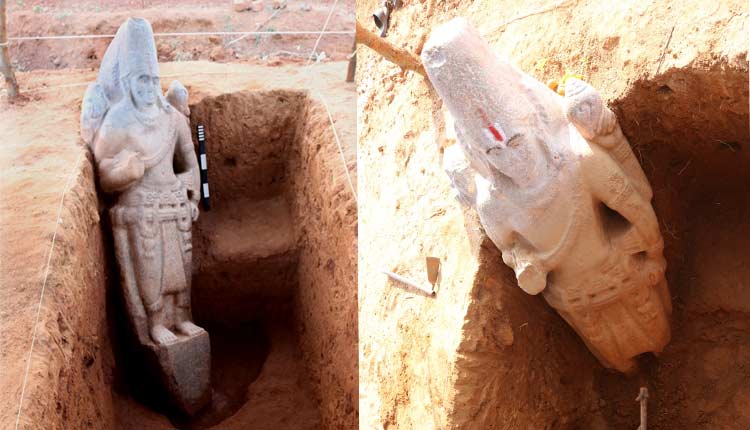New Delhi: The Archaeological Survey of India (ASI) has unearthed a 2000-year old historic trade settlement in Andhra Pradesh’s Gottiprolu village, along with a Pallava-period Vishnu statue, it said on Friday.
The excavation done, 80 kilometres east of Tirupati and Nellore, by the ASI team has discovered the remains of a huge settlement surrounded by a massive brick enclosure. Among many antiquities unearthed, is a life-sized Vishnu sculpture and a wide variety of pottery of the early centuries of the current era.

As per the ASI, a major find from the project was a two-metre high, four-armed Vishnu “standing over a pedestal carrying chakra and conch in his upper right and left hands respectively. The lower right is in bestowing boon and the left hand in ‘katihastha’ (resting on the hip) posture.”
On the basis of iconographical features such as elaborate headgear, thick holy thread and decorative drapery, ASI has dated it to 8th-century AD in the Pallava period, which is said to have ruled the area from early 4th to late 9th century AD.
However, other finds, like elliptical, circular and rectangular brick structures, possibly date back to a much earlier time.
“The available brick sizes (43-48 centmetres) are comparable with the Satavahana or Ikshvaku period structures in Krishna river valley (Amaravati and Nagarjunakonda). On the basis of brick size and associated findings, they can be placed anywhere between 2nd-1st century BC or little later, which makes them nearly 2000 years old,” the ASI said in a statement.
It also suggested that the site could have functioned as a trade centre, given the presence of Roman-style amphorae wares mostly used to transport liquid commodities. Proximity to the seacoast also suggests the site could have been a strategic settlement involved in maritime trade.
According to the ASI, “further explorations within a radius of 15 kilometers have revealed a fortified early historic settlement at Puduru, Subrahmanya temple at Mallam, a unique rock-cut laterite stepped well at Yakasiri, (and) Vishnu temple at Tirumuru”.
It also found a female terracotta figurine with two hands lifted upwards.
Other major antiquities unearthed include copper and lead coins, iron spear head, stone celts, terracotta beads, ear stud in semi precious stone and hopscotches. The ceramic assemblage of the site consisted of fine quality black and red ware, conical jars, rouletted sherds, and russet coated ware.
Source: Odishatv
Image Courtesy: OdishaTv
You may also like
-
India Can’t Afford to Remain Stagnant at this Juncture, Says PM Modi; Asks People to Buy Locally-Made Goods
-
Stolen Artefacts to be Returned to India from Scotland Museums
-
Legendary Singer Lata Mangeshkar Passes Away At the Age of 92
-
Netaji’s Hologram Statue at India Gate
-
10th Century Stone Idol of Goat Head Yogini IllegallyRemoved from A Temple in Lokhari, Banda, UP Being Returned to India
